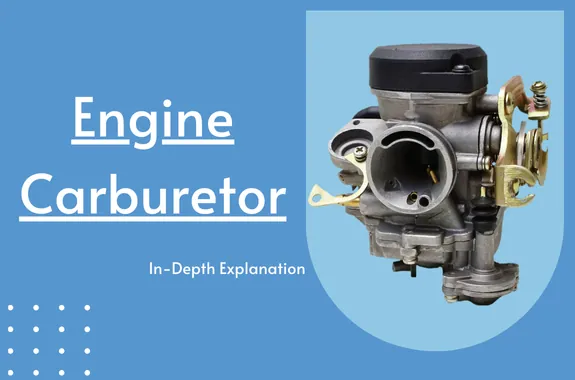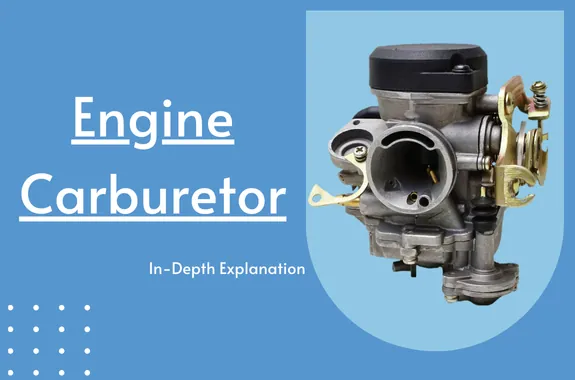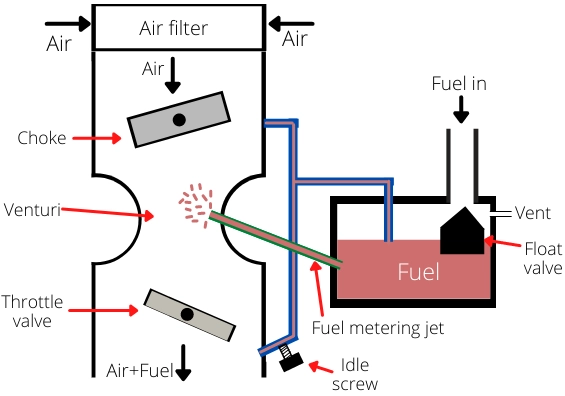A carburetor is a key part of an engine that mixes air and fuel for the proper combustion. It maintains the correct air-fuel ratio and is less expensive than fuel injection systems. It controls engine speed, helps start the engine in cold weather, and also stores some fuel.

Contents:
What is a Carburetor?
The carburetor is the component of the IC engine that helps for the mixing of air and fuel for the proper combustion of fuel.
It helps the engine to maintain the proper air-fuel ratio for its working. The carburetors are comparatively less expensive than modern fuel injection systems.

Function of carburetor in IC engine:
The carburetor has the following functions in IC engines:-
1] Mixing of air and fuel: In the case of an SI engine, the carburetor helps to supply atomized air-fuel mixture to the engine.
2] Engine speed control: The throttle valve provided in the carburetor helps to control the supply of air-fuel mixture to the engine. Therefore by controlling this valve the engine speed can be controlled.
3] Maintains proper air-fuel ratio
4] Cold start: During the cold season the choke provided in the carburetor helps to start the engine by lowering the supply of air and providing a rich mixture to the engine.
5] Fuel reservoir: The float reservoir stores a small amount of fuel.
Carburetor construction:
The simple carburetor consists of the following components:
- Float chamber
- Float and needle valve
- Choke valve
- Throttle valve
- Venturi
- Fuel metering jet

How does a basic carburetor work?
Let’s understand how it works with the help of the above simple carburetor diagram.
a] Filling the float chamber:
The fuel from the reservoir enters into the float chamber of the carburetor through an opening provided with a float valve. When the desired level of fuel is reached in the reservoir, the plastic float moves up and stops the fuel supply by the use of a needle valve.
b] Perparation of air-fuel mixture:
The air enters in the venturi through an air filter. The entry of the air in the Venturi is controlled by the choke valve provided above the venturi section.
During the operation of the engine, the air moves at a higher speed. When the air enters into the throat section of the venturi, the pressure of the air decreases below the pressure in the float chamber.
Due to this pressure difference, the fuel rises into the metering jet and mixes with the air in the throat section.
This atomized air-fuel mixture is supplied for engine combustion.
c] Throttling (Regulating fuel supply):
The throttle valve controls the supply of this air-fuel mixture.
When the throttling valve is partially open, less amount of air-fuel mixture enters into the engine and as the opening of the throttle valve increases, the supply of air-fuel mixture to the engine also increases.
FAQs:
-
What is carburetor and how it works?
Carburator is the mechanical component used in SI engines that helps for the mixing of air and fuel with proper air-fuel ratio.
-
Where is the carburetor located?
The carburetor is fitted between the air filter and intake manifold. It connects the air and fuel supply to the intake manifold.
-
What are the symptoms of a bad carburetor?
Some of the symptoms of a bad carburetor are:
1) Difficulty while the starting of the engine
2) Black smoke through the exhaust
3) Backfire
4) Engine overheating
5) Loss of power while acceleration -
What are the 3 types of carburetors?
Based on the position of the venturi the carburetors are classified as:
1) Updraught carburetor
2) horizontal draught carburetor
3) Downdraught carburetor
Read also: